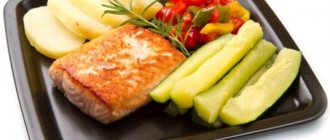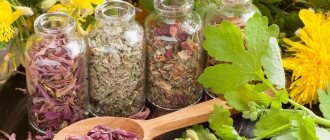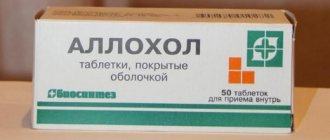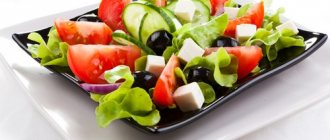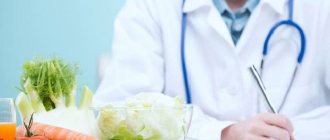Nutritional features and general principles of diet
Diet for stomach pain is an obligatory part of treatment; without it, restoration of the proper functioning of the organ is impossible. Drug therapy without following a diet will only give a temporary effect. Medicines usually only relieve symptoms of the disease, while following a strict therapeutic diet promotes a speedy recovery.
During an exacerbation of the disease, inflammation of the gastrointestinal tract appears. Because of this, some dishes begin to irritate the mucous membrane, causing discomfort and pain in the stomach. For problems with the intestines and stomach, it is important to eat food that promotes the healing of damaged tissues, gently cleanses the intestines, eliminates stagnation of bile and prevents decay.
Continuing to eat incorrectly, people only worsen their condition. The pain intensifies, forcing the patient to continue using antispasmodics and analgesics.
Healthy nutrition promotes the synthesis of the required amount of gastric juice with an optimal level of acidity. Sometimes only a diet can help a sick person escape from an illness and reduce the amount of medications he uses.
Patients suffering from gastrointestinal diseases are advised to follow some simple rules:
- eat a balanced and small diet (eat at least 5-6 times a day).
- the interval between meals should not be more than 3 hours.
- Do not eat very cold or hot food.
- It is not advisable to eat liquid and thick foods together.
- The dishes consumed should be prepared using gentle methods (boiling, steaming, stewing), frying is excluded.
- It is not recommended to combine meat and dairy products with carbohydrate foods.
- During exacerbation of diseases, you should avoid eating fatty foods and dishes high in fiber.
- In the first two months from the moment problems with the gastrointestinal tract arise, prunes and raisins are excluded from the diet; it is recommended to refuse fresh bread.
What can you eat when your stomach hurts? A healthy diet for stomach diseases includes eating fish, dairy products, meat, cereals, fruits and vegetables. Most diets for abdominal pain allow the presence of cauliflower, broccoli, carrots, pumpkin and boiled or baked potatoes in the diet. Squash and zucchini are useful in such cases.
It is allowed to eat stewed or baked apples, watermelons, melons, bananas, and pears are allowed. The meat consumed, like fish, should be lean and cooked in the oven or steamed. The most suitable cereals are oatmeal, buckwheat, and rice. The diet also includes low-fat yogurt, sour cream, sourdough, kefir and other fermented milk products.
For stomach pain, exclude from the diet anything that can irritate the liver, gastric mucosa or gall bladder.
The list of prohibited foods includes: fatty meats and fish, and citrus fruits (tangerines, limes, oranges, grapefruits and lemons), as they have quite high acidity and can irritate the gastric mucosa. If you have stomach pain during the diet, you should not use seasonings and spices that irritate the mucous membrane - mustard, ginger, chili pepper and other spicy and hot spices.
It is strictly prohibited to consume white cabbage, fast food, fried and fatty foods, grape and apple juices, chocolate, coffee, mint and alcoholic beverages.
Following these general rules and excluding irritating foods from the diet will help relieve pain during exacerbation of ulcers and gastritis. In addition, by including healthy foods in your diet, you can not only improve your health, but also lose weight.
Diet features
When following a diet, it is important to adhere to the following recommendations:
- Eating at a fixed time with equal intervals. This habit will help to establish the production of bile and gastric juice for the next meal, which prevents irritation of the stomach walls by excessive accumulation of an aggressive environment or indigestion caused by insufficient fermentation.
- Fractional meals involve eating 5–6 times a day, and portions must be reduced in size. As a result, the body receives all the necessary nutrients and calories, and the stomach is not overloaded.
- Avoiding too cold or hot food and drinks. Cold and carbonated drinks in combination with fatty foods slow down digestion, and hot food irritates the mucous membranes. The optimal food temperature ranges from 20 to 50 degrees with a plus value.
- It is better to prepare dishes by steaming or boiling. Baking in the oven is allowed, however, the formation of a golden brown crust on the products should not be allowed.
- Preference is given to liquid or grated through a sieve. Boiled vegetables, baked fruits, and pasta do not need to be ground, but when consuming, you must chew them thoroughly.
- Breakfasts should not be ignored; they should be light but nutritious.
- The duration of the diet is 10–14 days.
Diet for high acidity
For stomach pain caused by high acidity, follow a diet whose principles are:
- eating small portions of food;
- complete rejection of spicy foods and spices that stimulate gastric secretion;
- the presence in the predominant number of dishes rich in proteins - eggs, milk, vegetable oil;
- the last meal should be no later than 3-4 hours before bedtime;
- exclude the use of non-steroidal drugs and steroids.
Diet result
Following a gentle diet for 10–14 days will help eliminate inflammation, improve digestion, and eliminate pain symptoms. If the cause of stomach pain is serious pathologies of the gastrointestinal tract, such a diet will only slightly weaken the manifestations of the disease. If there are no positive results, or the condition worsens, you should immediately consult a doctor for examination.
In order to establish a preliminary diagnosis, the doctor interviews the patient, finds out in what situations pain occurs, what is its intensity, and whether there are accompanying symptoms. It is very important to determine the connection between the occurrence of pain and food intake, as well as the nature of the foods consumed.
Excluding spicy, fatty, fried and rough foods from the diet has a positive effect on the stomach and pancreas, and allows you to quickly return to normal life, forgetting about discomfort and pain.
Nutrition for colitis, enterocolitis and dysentery
For colitis, enterocolitis and dysentery, the goal of the diet is to minimize inflammatory, fermentative and putrefactive processes that can occur in the intestines. The diet in this case should be based on products that help increase peristalsis and increase the secretion of gastric juice.
Food allowed for consumption is low in carbohydrates and fat. As a rule, such a diet is designed for a week.
All dishes should preferably be in a puree, liquid, pureed state. The cooking method should be boiling and steaming. The permitted products include: wheat crackers, soups with weak fish or meat broth, lean poultry, rabbit meat, beef, fermented milk products, and vegetable infusions. The following cereals are allowed: semolina, rice, oatmeal, buckwheat. From berries and fruits - blueberries, pears, quinces, apples, dogwoods.
General principles of nutrition
To facilitate the treatment of any disease affecting the digestive tract, it is important that the patient adheres to proper nutrition. The attending physician will help him with this and will create a dietary menu.
A person is allowed to eat food only in liquid form. It also needs to be light. All dishes must be warm. Food that is too hot or cold irritates the mucous membrane.
It is recommended for patients diagnosed with ulcers to take mushy food. Such dishes minimize the mechanical impact on the digestive tract. IN
light foods do not contain fiber, which also has an irritating effect on the walls of the organ.
Creating a menu is not particularly difficult. You can combine permitted foods and liquids, but prohibited foods should be excluded.
Everything should be fresh and clean. Before consuming any food, it is important to make sure that it will not cause harm to your health.
Vegetables are not recommended in their raw form; it is advisable to boil or steam them. It is better to grind everything using a blender or meat grinder. This helps to significantly reduce the load on the stomach during digestion.
Overeating is strictly prohibited . At first, a person may feel slightly hungry, because the body, accustomed to receiving food in large quantities, requires a supplement. This habit needs to be overcome.
Mild malnutrition is better than heaviness and nausea. Reducing the amount of food helps to reduce excess weight, which will also be beneficial.
When treating, it is important not only to choose the right foods, but also to eat them correctly. To do this, nutritionists have developed several simple recommendations that should not be neglected:
- It is advisable to eat every day at certain hours, so the stomach can get used to the established regime.
- Meals are fractional, up to six times a day, in small portions.
- The temperature of cooked dishes should not exceed 70 degrees, but it is undesirable for it to be below 15. This does not make it necessary to keep a thermometer with you all the time, as long as the food is warm.
- The products consumed must be thoroughly crushed.
If these rules are followed, rapid recovery of the digestive system is guaranteed.
Diet for stomach ulcers
During an exacerbation of an ulcer, the diet is quite strict. Bread and vegetables are excluded from the patient's menu. They are replaced with boiled lean meat, porridges, slimy soups, soufflés and jelly. This diet is followed for three weeks. Afterwards, the diet is supplemented with baked fruits, dairy products, boiled low-fat fish, vegetable soups and day-old bread.
During remission, the patient is allowed a more varied menu, which will help restore the proper functioning of the digestive system. The menu includes soups, cheeses, boiled tongue and caviar are allowed. The list of prohibited foods includes onions, garlic, fried and fatty foods.
Forbidden food
If the pain symptom is intense, it is recommended to avoid many foods during treatment.
First of all, these are foods that contain high amounts of fat, increase acidity, or can trigger a heart attack.
The list of prohibitions includes the following undesirable products:
- Coffee. It is forbidden to drink not only a drink with caffeine, but also without it. It irritates the mucous membrane, which causes even more severe pain.
- Carbonated drinks.
- Red meat.
- Dishes prepared with the addition of heavy cream.
- Various baked goods, which also provoke an inflammatory process.
- Trans fats, because they negatively affect the organs of the digestive system.
- Citrus fruits - tangerines, lemon, oranges. Unlike other fruits, they have high acidity.
- Spicy food and spices. It has not yet been proven that eliminating these foods will help the ulcers disappear, but it will be useful in reducing severe symptoms.
- Chocolate and products made from it.
- Mint and pepper.
- Alcohol products. Alcohol-containing drinks stimulate acid secretion, which is fraught with negative consequences.
- Cigarettes. They slow down the healing process and cause even more damage to the stomach.
- White cabbage.
- Mayonnaise and sauces.
- Smoked meats and sausages.
- Radishes, turnips.
It is definitely recommended to reduce salt intake to a minimum, as it interferes with the excretion of water and destroys the gastric mucosa.
To completely restore the normal functioning of the digestive organs, it is important to strictly follow all the doctor’s instructions regarding a healthy diet.
Allowed drinks for stomach pain
In addition to eating certain types of foods, you should maintain optimal water balance in the body. To do this, you can drink not only plain water, but also drinks that will not only replenish the fluid balance in the body, but also help normalize the functioning of the stomach and strengthen overall health. When you feel stomach pain, you can drink the following drinks:
- infusion of chamomile or rosehip;
- the tea is not strong;
- still mineral water;
- pumpkin juice;
- decoction of flax seeds;
- jelly and cocoa;
- banana and strawberry smoothie;
- dried fruits compote.
Video on the topic:
Why is it important to eat according to your diet if your stomach hurts?
The diet directly depends on what kind of stomach disease is diagnosed in a particular clinical case. If a person has been suffering from severe pain in the stomach area for a long period of time, then it is undoubtedly necessary to see a gastroenterologist as soon as possible.
After undergoing a comprehensive examination and passing the established list of tests, the doctor will refute suspicions that the patient has a stomach pathology, or make a diagnosis of one or another gastrointestinal disease.
If, according to the results of the examination, a stomach disease is indeed confirmed, then the patient needs to organize his diet according to the diet in order to:
- prevent further spread of the inflammatory process of the gastric mucosa (correctly selected products and dishes prepared on their basis will prevent exacerbation of gastritis, which quite often happens with high acidity);
- promote faster healing of ulcerative formations if the painful state of the digestive system is associated with the appearance of tissue erosion;
- eliminate spasm of muscle fibers located in the circumference of the gastrointestinal tract organs and responsible for grinding food that enters the organ cavity during its intake;
- reduce the concentration of hydrochloric acid in gastric juice and prevent the appearance of such an unpleasant symptom as heartburn, or erosion of the edges of ulcerative formations;
- improve gastrointestinal motility and ensure a more active process of digestion and absorption of food, which is especially important for patients suffering from too low acidity and slow stomach function.
Each type of product has certain properties and an individual effect on the functioning of the digestive system of a particular person. Therefore, it is necessary to select food according to the specific ailment.
This should be a complete diet with a detailed schedule of meals for all 7 days of the current week. Otherwise, the stomach will not stop hurting, and the general therapeutic course will not bring a 100% recovery effect.
Sample diet for stomach pain
A sample menu for stomach pain may look like this:
| Eating | Sample menu |
| Breakfast | Oatmeal or steam omelette, tea with skim milk |
| Lunch | Small cracker with low-fat milk |
| Dinner | Puree potato soup, steamed cutlets with a side dish of vegetables, fruit jelly |
| Afternoon snack | Skim milk (glass) |
| Dinner | Low-fat boiled sea fish, garnished with carrot and beet puree, weak tea |
| Before bedtime | Milk – 1 glass |
To avoid difficulties in preparing meals every day during a diet, you need to create a sample menu for the week, including a variety of recipes for dishes from permitted products.
Diet No. 1
The “Table No. 1” diet is prescribed to patients who suffer from stomach pain due to the following pathologies:
- chronic gastritis with increased or preserved secretion;
- ulcer;
- exacerbation of acute gastritis.
Food consumed by patients on diet No. 1 should be steamed or boiled. All dishes must be ground. You can prepare dishes using the baking method, but without a crust. It is recommended to eat small portions 4-5 times a day. This diet lasts from 3 to 5 months.
| Allowed | Forbidden |
| White bread crackers, biscuits | Fat meat |
| Mashed cottage cheese, dry, condensed and whole milk, cream | Smoked meats, marinades, pickles, sauces, canned food |
| Lean types of meat and fish: beef, veal, chicken, turkey, rabbit, pike perch, carp, perch | Fatty fish |
| Buckwheat, oatmeal, rice, semolina - porridges made from them and soups (ground), pasta, noodles | Bread |
| Steamed omelette, soft-boiled eggs (no more than 2 pieces per day) | Brown bread, pastry, various pies |
| Butter. Refined oil is added to prepared food | Raw fruits |
| Vegetable puree soups, dairy, it is allowed to add cream, eggs, milk to them | Vegetables: white cabbage, cucumbers, radishes, turnips, sorrel, spinach, onions |
| Mild cheese, low-fat and unsalted ham, dairy, diet, doctor's sausages | Ice cream, chocolate |
| Vegetables: carrots, pumpkin, zucchini, potatoes, cauliflower, beets | Coffee, kvass, carbonated drinks |
| Compotes of sweet fruits and berries, jam, jelly, mousses, marshmallows, jelly, marshmallows, sugar | Mushrooms |
| Rosehip decoction, tea with cream or milk, weak cocoa | Fish, meat decoctions and broths |
Diet No. 1A
Diet 1A is prescribed to patients with exacerbation of gastritis or ulcers (with increased gastric secretion) for a period of 6-12 days, depending on the general condition of the patient. This type of diet is quite gentle. All dishes are steamed or boiled. Eating should occur up to 6 times a day, at equal time intervals (2-3 hours).
The list of allowed and prohibited foods looks like this:
| Allowed | Forbidden |
| Steam soufflé or puree from beef, veal, rabbit | Any types of bread and flour products |
| Milk liquid porridges made from rice or buckwheat flour, semolina, oatmeal | Dairy products, cheese |
| Low-fat fish, boiled or steamed | Fatty meats and poultry |
| Cream, milk, steamed curd soufflé, milk jelly | Fatty fish |
| Steamed omelette, soft-boiled eggs | Vegetables |
| Butter or olive oil | Mushrooms |
| Mucous decoctions in milk from rice, barley, oatmeal | Fresh fruits |
| Vegetable purees without salt and sugar | Pasta, legumes |
| Honey, sugar, | Spices, sauces |
| Jelly, mousse from non-acidic fruits | Coffee, cocoa, kvass, carbonated drinks |
| Decoctions of rose hips, wheat bran, tea with added milk or cream, juice from non-acidic fruits diluted with water | Meat, vegetable, fish broths |
How to cook food for a sick stomach?
For stomach pain, not only lists of prohibited or permitted foods are important. You need to know how to cook them correctly. Only gentle methods are used. You can wipe finished dishes with a sieve, but it’s faster and easier to use a blender. Sometimes you can use a pestle.
Basic methods of gentle cooking:
- classic cooking. Carried out in water. You can add laurel and vegetables to improve the taste of the product. If broth is used, the water must be changed at least once;
- steaming. A gentle way to prepare vegetables, poultry, fish, meat without immersing the product in water. Suitable for stomach pain. It is believed that the taste properties of the product in this method are higher, and more vitamins are also retained;
- stewing. In this case, it is carried out either with water or with low-fat broths. Sometimes milk is used, it all depends on the dish. A small amount of liquid is added, simmering occurs over low heat;
- baking. Unlike classical methods of cooking in the oven, if you have stomach problems, there is no need to cook food until golden brown. They are often baked under foil, a lid, or in a bag;
- bakery. Basically, biscuits are prepared for stomach pain. Charlottes, sometimes bread. You can bake using standard methods, but use only on the second day. To save time, you can freeze biscuits.
When your stomach hurts, your diet becomes much stricter. Baked foods are removed from the diet, no crusts, butter and sour cream dressings, desserts with sugar and pastries. The diet is dominated by boiled foods, whipped to a creamy consistency. Cereals with a grain coating and pasta are excluded for the time being.
Menu for a sick stomach and intestines
On the first day for breakfast, prepare semolina pudding, tea with cheese and honey. Between breakfast and lunch, snack on a banana. Lunch contains soup, baked fish, and boiled rice. For dinner – cottage cheese casserole, herbal tea. Shortly before bedtime, drink kefir.
Breakfast on the second day may consist of mashed potatoes, herring, bread, butter, tea. Snack – compote. Lunch – borscht, potato casserole with meat, tomato juice. Dinner includes lazy cottage cheese dumplings, sour cream, tea. Before going to sleep, you are allowed to eat a baked apple with honey.
Breakfast on the third day consists of rice-apple casserole and cocoa with milk. Snack – blueberry jelly. Lunch: soup cooked in a weak broth, meat cutlets with noodles, berry compote. Dinner includes boiled potatoes with baked low-fat fish and cocoa. At night - drink yogurt.
The Thursday breakfast menu consists of pasta and cheese, low-fat ham, and coffee with milk. Between breakfast and lunch it is recommended to eat a baked apple. Lunch contains rice soup, buckwheat porridge with meatballs. On the third day it is permissible to drink jelly. Dine on fried fish and mashed potatoes. Wash it down with compote. At night, traditionally, we drink yogurt.
On Friday, prepare semolina pudding, buttered bread and tea for breakfast. Between breakfast and lunch you can eat a banana. For lunch, eat soup with grated vegetables, for example, cauliflower and carrots. For the second course - mashed potatoes, steamed meatballs. For the third you can drink compote. You can have a vegetable stew for dinner. For dessert – marshmallows and tea. Before going to sleep, they traditionally drink kefir.
On Saturday you can make pancakes with cottage cheese for breakfast. Drinks: coffee or tea. Between breakfast and lunch - a banana. For lunch - beetroot borscht with sour cream, mashed potatoes with boiled sausage, tea. For dinner - cabbage rolls, tea with crackers.
Breakfast on the seventh day of the diet can consist of liquid porridge, such as oatmeal, soft-boiled eggs, cheese, and tea. Between breakfast and lunch, snack on mousse or smoothie. For lunch, eat noodle soup and baked chicken in sour cream. For the third - jelly. Dine with rice and boiled meat. For dessert - two marmalades with black tea. Before going to sleep, we drink kefir.
Nutrition at different acidity levels
Depending on the course of the pathological process, the doctor may recommend that the patient adhere to one of the standard diets.
The recommendations of each of them are in addition to the general requirements. This is a kind of adjustment of the food list depending on the state of the body.
Increased acidity
Therapeutic diet is used to eliminate ulcers, gastritis and poisoning caused by food or bacteria. It is also needed if there has been damage to the gastrointestinal tract of chemical or mechanical origin. The main task of such nutrition is to eliminate any irritants that negatively affect the organ.
Recommended Products:
- dairy dishes;
- cottage cheese and cheese;
- sweet juices;
- mineral still water;
- strong tea;
- non-acidic peeled fruits;
- boiled liver;
- sturgeon caviar.
It is necessary to exclude:
- porridge;
- bread made from rye and bran;
- marinades and preserves;
- various broths;
- vegetables, fruits and drinks with high acidity.
Salt, fatty foods, sour cream and eggs are also prohibited. If there is a large loss of electrolytes, it is allowed to consume fermented milk products and pickled foods.
Low acidity diet
This diet helps to gently stimulate gastric secretion.
Allowed to eat:
- butter;
- soft fermented milk products;
- lean fish and meat, baked or stewed;
- ripe fruits;
- vegetables, cooked in the oven or boiled.
Excluded:
- natural milk;
- legumes;
- chocolate;
- figs;
- raw vegetables.
The consumption of salt, permitted fats, grapes and kvass is also kept to a minimum. After the pain disappears, canned food is gradually introduced, which helps to increase acidity.
Menu for a sick stomach for every day
On Monday morning, prepare oatmeal or buckwheat porridge with low-fat milk. For drinks, it is recommended to drink fruit juice or tea. Fruit salad is eaten as an afternoon snack. Lunch of the first day consists of vegetable soup, bread and compote. For dinner on the first day, steamed fish or boiled chicken is prepared. For drinks, it is recommended to drink tea.
On Tuesday they have breakfast with an egg omelet and green tea. Snack on fruits, vegetables or juice from them. For lunch, it is recommended to cook buckwheat porridge with boiled root vegetables. For drinks, it is recommended to drink tea. For the second afternoon snack, fresh vegetables are consumed. In the evening they have dinner with root vegetable stew and boiled beef.
On Wednesday morning they prepare oatmeal with fruit. The drink can be tea or rosehip drink. The second breakfast consists of low-fat kefir and bread. During lunch, pasta with baked fish is prepared. Drinks include tea or jelly. For a snack before dinner, make carrot juice. The end of the third day consists of vegetables with boiled chicken.
On Wednesday morning they prepare oatmeal with fruit.
Breakfast on Thursday is 2 soft-boiled eggs and tomato juice. For the first afternoon snack, make a vegetable salad with cabbage. For lunch, boiled rice with dietary meat is prepared. For drinks, tea or compote is recommended. During the afternoon snack they eat a vegetable salad. Thursday dinner consists of boiled meat or fish, bread and black tea.
Friday breakfast consists of compote and oatmeal. For the first afternoon snack, drink a glass of low-fat kefir. During lunch they eat puree soup with bread. Have a snack with vegetable salad. Friday dinner consists of vegetable stew and boiled beef.
On Saturday morning they eat buckwheat porridge, which is prepared with low-fat milk. As a drink, drink jelly or compote. Have a snack before lunch with vegetables or juice from them. For lunch, make pasta with baked or steamed fish. The second afternoon snack consists of bread. For dinner, steam vegetables with boiled chicken.
On Sunday morning they eat an apple with cottage cheese or oatmeal. The first afternoon snack consists of a banana and a glass of juice. For lunch, steamed fish with vegetables is prepared. Tea or compote is made as a drink. A pre-dinner snack consists of a glass of low-fat kefir. For dinner, it is recommended to eat fresh vegetable salads, stews or root vegetables.
Recommendations for a gentle diet for the stomach
A more strict diet is recommended for exacerbation of peptic ulcer disease, accompanied by severe pain. In this case, milk and dairy products are preferred.
- For such patients, the day begins and ends with a glass of milk.
- Indispensable on the menu are liquid porridges with water, especially mucous ones, which are necessarily included in the daily diet of patients.
- The first courses are prepared only with vegetable broths. Meat and fish broths are excluded for the entire duration of the exacerbation of the disease.
- Second courses of fish or poultry are prepared by steaming or boiling and served in the form of cutlets or meatballs.
- Among the drinks, preference is given to various jelly.
When eaten, food should be warm, no higher than 60 degrees, and not cold, no lower than 20 degrees. A mandatory condition of the diet is split meals six times a day with a single amount of food not exceeding 250-300 grams.
Such a diet, during an exacerbation of the ulcer, should be maintained for two to four weeks or more. As the pain syndrome subsides and signs of exacerbation of the disease, some relaxation in the diet will be possible in the future.


